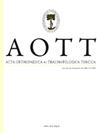Radiographical and clinical results of a new conservative treatment algorithm in Legg-Calvè-Perthes disease: A retrospective study
IF 1.1
4区 医学
Q3 ORTHOPEDICS
引用次数: 0
Abstract
Objective: This study aimed to establish a feasible conservative treatment algorithm for Legg-Calvè-Perthes Disease (LCPD), clarify its limitations, and evaluate the correlations between radiographical and clinical results. Methods: Patients diagnosed with LCPD and treated conservatively were evaluated retrospectively; 39 hips from 35 patients were included. The treatment protocol consisted of intermittent manual traction, range of motion exercises, activity limitation, bed rest, NSAID (ibuprofen 100mg/5mL), and ASA (100mg/day) during attack periods. The treatment protocol was standardized, and an algorithm was established for all the patients. Results: The mean follow-up was 13.7 (range = 8-22) years. According to the Stulberg classification, 26 (67%) hips were good, 6 (15,3%) were fair, and 7 (17%) were poor. No activity-limiting pain was detected in any patient. The mean Harris score was 90.5 ± 5.3 for Stulberg type 1, 2, and 3 hips, but 84.2 ± 8.8 for Stulberg type 4 and 5 hips. When the patients were evaluated in terms of pain, activity, and function, it was seen that pain and activity were not different, especially in the Stulberg 1, 2, 3, and 4 patients during the mid-term follow-up. The function was the main factor correlating with the Stulberg classification. Twenty-nine (82.8%) families defined the applicability of the treatment protocol as “easy,” 4 (10.3%) defined it as “moderate,” and 2 (6.2%) defined it as “difficult.” Conclusion: The present study demonstrated that the treatment protocol was successful and easily applicable to LCPD. Although lateral pillar classification was efficient to predict radiographic results, the Stulberg classification was not correlated with the clinical results for every subgroup. Level of Evidence: Level IV, Therapeutic Studylegg - calv - perthes病一种新的保守治疗方法的影像学和临床结果:回顾性研究
目的:本研究旨在建立可行的legg - calv - perthes病(LCPD)保守治疗算法,明确其局限性,并评价影像学与临床结果的相关性。方法:对诊断为LCPD并经保守治疗的患者进行回顾性评价;纳入了35例患者的39髋。治疗方案包括间歇性手动牵引、活动范围练习、活动限制、卧床休息、发作期间非甾体抗炎药(布洛芬100mg/5mL)和ASA (100mg/天)。规范了治疗方案,建立了适用于所有患者的算法。结果:平均随访时间为13.7年(8 ~ 22年)。根据Stulberg分类,26例(67%)髋部良好,6例(15.3%)髋部一般,7例(17%)髋部不良。所有患者均未发现活动限制性疼痛。Stulberg 1型、2型和3型髋关节的Harris平均评分为90.5±5.3,而Stulberg 4型和5型髋关节的Harris平均评分为84.2±8.8。在对患者进行疼痛、活动和功能评估时,我们发现疼痛和活动并无差异,尤其是中期随访的Stulberg 1、2、3和4例患者。该函数是影响Stulberg分类的主要因素。29个(82.8%)家庭将治疗方案的适用性定义为“容易”,4个(10.3%)家庭将其定义为“中等”,2个(6.2%)家庭将其定义为“困难”。结论:本研究表明该治疗方案是成功的,易于应用于LCPD。虽然侧柱分类能有效预测影像学结果,但Stulberg分类与每个亚组的临床结果并不相关。证据等级:IV级,治疗性研究
本文章由计算机程序翻译,如有差异,请以英文原文为准。
求助全文
约1分钟内获得全文
求助全文
来源期刊

Acta orthopaedica et traumatologica turcica
ORTHOPEDICS-
CiteScore
2.00
自引率
0.00%
发文量
66
审稿时长
>12 weeks
期刊介绍:
Acta Orthopaedica et Traumatologica Turcica (AOTT) is an international, scientific, open access periodical published in accordance with independent, unbiased, and double-blinded peer-review principles. The journal is the official publication of the Turkish Association of Orthopaedics and Traumatology, and Turkish Society of Orthopaedics and Traumatology. It is published bimonthly in January, March, May, July, September, and November. The publication language of the journal is English.
The aim of the journal is to publish original studies of the highest scientific and clinical value in orthopedics, traumatology, and related disciplines. The scope of the journal includes but not limited to diagnostic, treatment, and prevention methods related to orthopedics and traumatology. Acta Orthopaedica et Traumatologica Turcica publishes clinical and basic research articles, case reports, personal clinical and technical notes, systematic reviews and meta-analyses and letters to the Editor. Proceedings of scientific meetings are also considered for publication.
The target audience of the journal includes healthcare professionals, physicians, and researchers who are interested or working in orthopedics and traumatology field, and related disciplines.
 求助内容:
求助内容: 应助结果提醒方式:
应助结果提醒方式:


